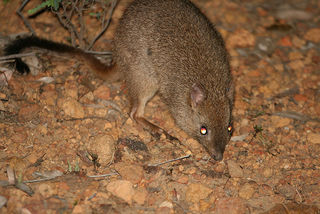
Original source: http://www.flickr.com/photos/arthur_chapman/3009409238/in/photostream
Author: arthur_chapman
Brush-tailed bettong
Order : Diprotodontia
Family : Potoroidae
Species : Bettongia penicillata
Keywords: nocturnal , red , tail
The Brush-tailed bettong, brush-tailed rat kangaroo, woylie is listed as Conservation Dependent (LR/cd), the focus of a continuing taxon-specific or habitat-specific conservation programme targeted towards the taxon in question, the cessation of which would result in the taxon qualifying for one of the threatened categories below within a period of five years, on the IUCN Red List of Threatened Species
Countries
AustraliaSome facts about the
Woylie
Adult weight : 1.5 kg (3.3 lbs)
Maximum longevity : 19 years
Female maturity :180 days
Gestation : 18 days
Weaning : 150 days
Litter size : 1
Interval between litters : 102 days
Weight at weaning : 0.5 kg (1.1 lbs)
Basal metabolic rate : 3 W
Body mass : 1.018 kg (2.2396 lbs)
Temperature : 36.85 °C (98.33 °F)
Facts about the brush-tailed bettong
) The brush-tailed bettong is a marsupial that once inhabited more than 60% of the Australian mainland but now occurs only on less than 1%. (Full text)
The Brush-tailed Bettong is a member of the Potoroidae family and is often called the ‘Brush-tailed Rat-Kangaroo’ or ‘Woylie’.
The Brush-tailed Bettong is a [CITIES-listed Endangered Species]
Description The Brush Tailed Bettong is a small marsupial living in Australia.
The Brush-tailed Bettong The Brush-tailed Bettong is a small mammal, about (10-17 inches) in length, and tail is about (9-13 inches). (Full text)
The Brush-tailed Bettong is listed as Rare in South Australia.
The Brush-tailed Bettong is a small ground dwelling marsupial that was extremely common throughout South Australia at the time of European settlement.
Brush-tailed Bettong is potentially available in five (5) land systems in Cathedral Cave’s catchment and in six (6) land systems in Kenniff Cave’s catchment (Tables X.
Co-ordinator of the program Calperum's Senior Ecologist Sonia Dominelli says the brush-tailed bettong is now vulnerable in South Australia and the plains mouse is a rare rodent. (Full text)
"The brush-tailed bettong is resilient, adapted to a range of habitats, and because of the conservation work done in Western Australia, is relatively common in that state.
The brush-tailed bettongs are considered at risk in the wild.
At these sites, Brush-tailed Bettongs are being used to demonstrate the effectiveness of intensive introduced predator/competitor management.
Threats to Survival Brush-tailed Bettongs are an endangered species, on the edge of extinction.
Hence Brush-tailed Bettongs are expected as a major contributor to the Cathedral Cave archaeological fauna assemblage if this strategy influenced the archaeological fauna assemblage formation.
In the smaller macropods, the Rufous and Brush-tailed Bettongs are as popular as ever, as are the Long-nosed Potoroos. (Full text)
Brush-tailed Bettongs are from Australia.
Hence Brush-tailed Bettongs are expected as a major contributor to the Cathedral Cave archaeological fauna assemblage if prehistoric Aboriginal people employed strategy 3. (Full text)
More animals beginning with B
